Black trumpet mushrooms, nicknamed the “poor man’s truffle,” are one of the most treasured wild edible mushrooms. These mushrooms are deep gray to black and grow up to 3 inches wide. They look like Gothic flowers blooming from the forest floor.
Because of their dark coloring and small stature, black trumpet mushrooms are challenging to find. Even seasoned foragers struggle some years. But the reward for finding these culinary gems is worth the effort! Black trumpets have an intense, bright, nutty, sweet flavor and a very potent earthy and musky smell.
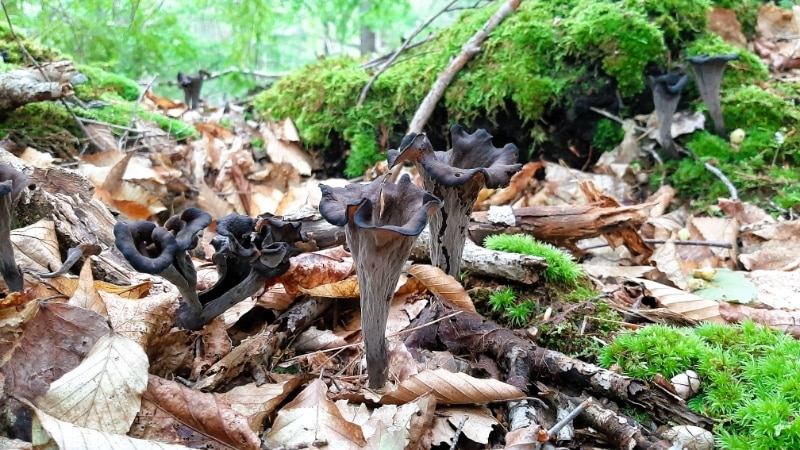
Currently, there are no known ways to cultivate black trumpet mushrooms, which means the only way to taste them is to find them in the woods yourself and make some good mushroom foraging buddies! Sometimes, you can find them at local farmer’s markets or specialty markets, but that certainly cannot be relied upon.
Black trumpet mushrooms are the perfect beginner mushroom species because they have no poisonous look-alikes. This makes them a safe choice to start your foraging journey. This piece will show you the best ways to clean and cook these flavorful fungi, whether you’ve gathered them yourself or bought them fresh from the market.
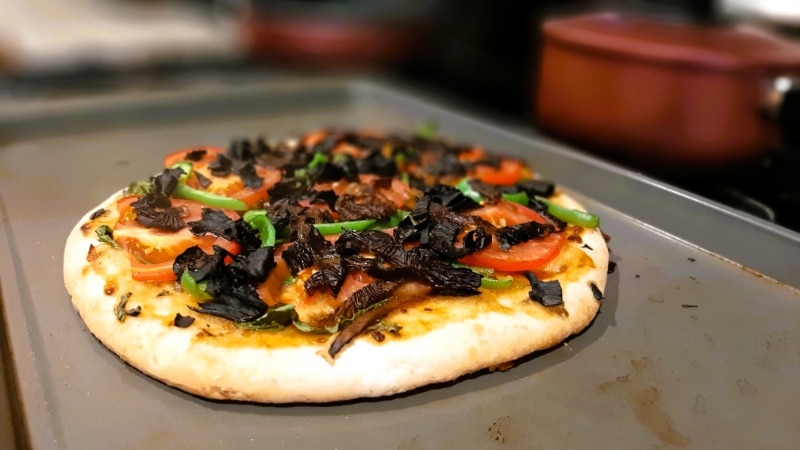
Jump to:
What Are Black Trumpet Mushrooms
The black trumpet mushroom, also known as the horn of plenty, is a wild fungi with a distinctive vase-like shape. They are very versatile in the kitchen and have a distinct and absolutely delicious flavor.
Black trumpets grow in funnel shape between 1 to 5 inches tall and 3 inches wide. Their flesh is paper-thin and creates a hollow, tube-like structure without the typical cap, stem, or gills you’d find in other mushrooms.
The mushroom’s surface is mostly smooth and ranges from deep black to dark gray. The coloring often fades to tan in sunlight. The upper part of the mushroom spreads out into a funnel with wavy, curled edges that look just like a flower.
One of the black trumpet’s standout features is its smooth underside, which doesn’t have any visible spores, gills, pores, or teeth. There are subtle wrinkles and forked ridges running from the cap down the stem instead. The mushroom’s delicate flesh breaks easily, and the whole thing feels like suede to the touch.
There is more than one species of black trumpet mushroom in North America. All of them are edible. The primary species in North American are:
- Craterellus fallax, the Fragrant Trumpet
- Craterellus foetidus, the Cerulean Black Trumpet
- Craterellus caeruleofuscus, the California Black Trumpet
- Craterellus cinereus, the Ashen Chanterelle
Many guide books still list Craterellus cornucopioides as a species here, but recent DNA analysis suggests that this is a European species only.

What’s So Great About Black Trumpet Mushrooms
Black trumpets taste unlike any other mushroom. They have a rich, smoky, and nutty flavor with earthy undertones. On top of that, they have a subtle sweetness that makes their taste even more interesting. It’s a complicated flavor to define in words as it’s very unique and complex.
Fresh black trumpets smell amazing, too. They have a fruity scent that is reminiscent of ripe apricots or black cherries. The sweet, woodsy aroma gets even stronger after cooking. This is another reason they’re so great to cook with. Their unique combination of taste and smell works well in so many dishes.
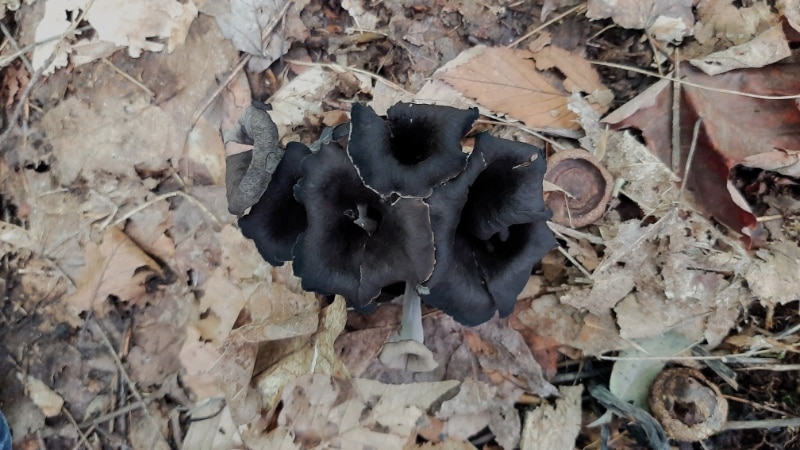
Black trumpets are small and delicate with very thin flesh. This isn’t a mushroom you’re going to create a main dish out of — they are more of a flavoring component. And you do have to use them sparingly since their flavor can be pretty intense.
Dried black trumpets are even more intense in flavor and smell than fresh. The drying process concentrates the aromas and creates a super-pungent, flavorful seasoning.
Black trumpet mushrooms can be eaten raw but not in large amounts. They are great as a small garnish (1 or 2 mushrooms, tops). We don’t know if eating more than that raw will make you sick, but we, in general, always err on the side of caution. Also, 1-2 raw black trumpets are plenty to get their flavor profile in the dish.

How To Harvest Black Trumpet Mushrooms
The best way to prepare black trumpet mushrooms starts at the time of harvest. Inspect each mushroom as you harvest it to make sure it is of good quality. Black trumpets can decompose easily because their flesh is so thin.
The mushrooms should feel dry and firm enough to keep their trumpet shape. They should have an earthy, fragrant smell. Stay away from any mushrooms with sour or unpleasant odors.
The vase shape of black trumpet mushrooms means they tend to collect debris inside them. Usually, it’s not too stuck on or difficult to remove, but it can get time-consuming. The best way to reduce cleaning time is to avoid collecting these mushrooms near pine trees or after heavy rain. Of course, that’s not always a practical approach. If you stumble upon them in the woods, you’ll want to forage them regardless of surrounding trees or weather conditions.
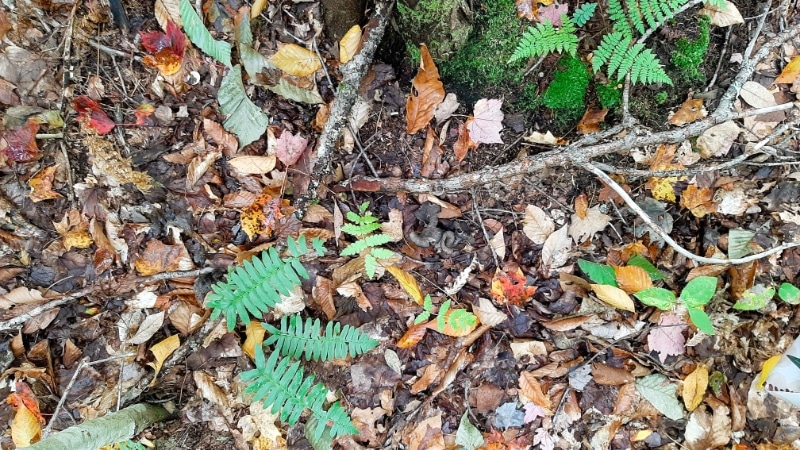
A good harvesting method is to use scissors or a sharp knife to cut off each mushroom at its base. The base is stuck in the soil and usually covered with dirt. If you leave the base of the stem on the mushroom, it’ll spread dirt to all the others in the basket and create a bigger cleaning job later on. You can also pluck the mushrooms out of the ground and then cut off the base of the stem. Either method is acceptable.
After you’ve harvested the mushroom, split each trumpet lengthwise to see inside the cavity. This helps you check and clean both inner and outer surfaces thoroughly. Brush out any debris before adding the black trumpets to your basket.
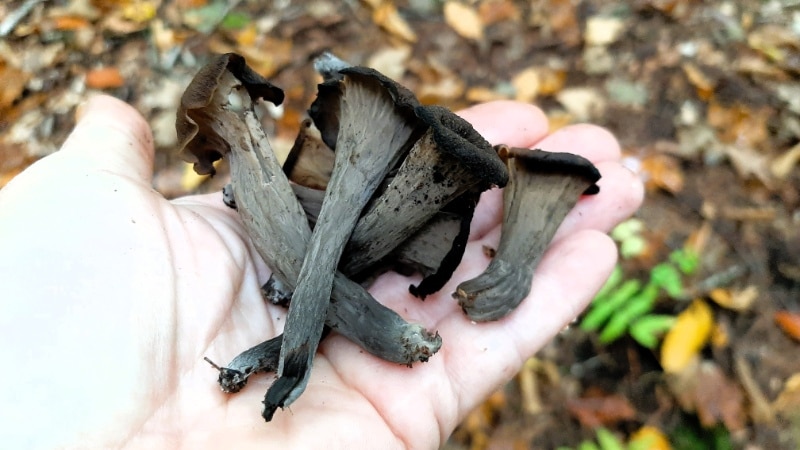
Because black trumpet mushrooms are super delicate, be careful how you gather them. Do not put them in a basket or bag with bigger or heavier mushrooms you’ve found. Black trumpets are very easily crushed. Also, the best basket or bag is shallower than it is tall. If they are all piled on top of each other in a tall basket, they’ll get squished and will crumble to pieces.
We always carry brown paper bags for gathering black trumpet mushrooms. We do this so they can be kept separate and also because paper bags are lightweight to carry.
If you treat the mushrooms carefully as you collect them, there’s a much better chance of getting them home in one piece. Crumbled-up black trumpet mushrooms aren’t worthless; they can be dried and used as a seasoning, but it’s much better to have the mushrooms intact to really show them off in a dish.
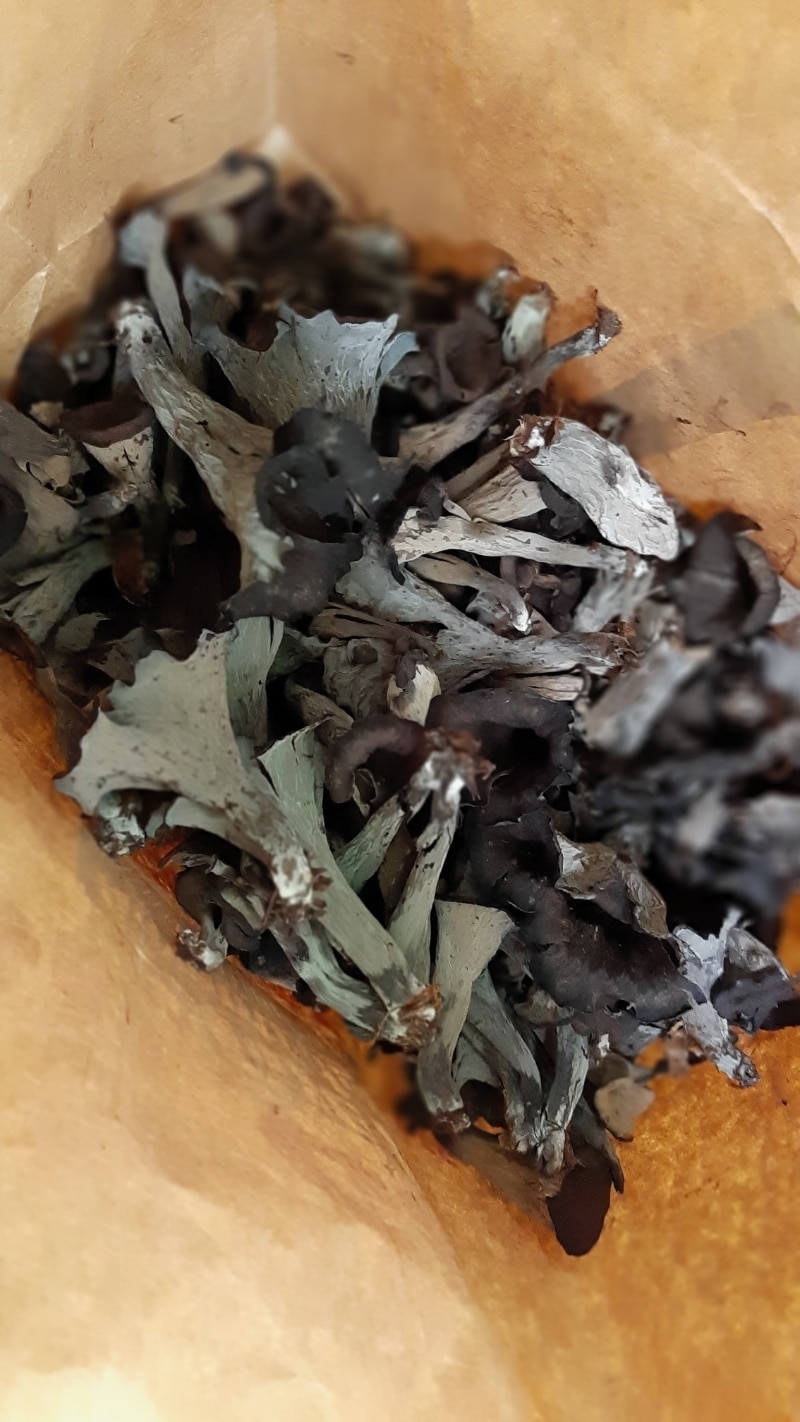
How to Clean Black Trumpet Mushrooms
** DO NOT CLEAN YOUR MUSHROOMS UNTIL YOU PLAN TO COOK WITH THEM.** If it will be a few days between the date of harvest and cooking, put the black trumpets in a paper bag unwashed and store them in the refrigerator. Do not get them overly wet in any way before storing or they will rot very quickly. They can be stored dry in a paper bag in the refrigerator for up to 5 days. Place a very lightly dampened paper towel over the mushrooms to retain a small bit of moisture. The mushrooms may still be okay after 5 days, but you’ll find they tend to dry out, and their flavor won’t be as strong.
When you get your black trumpet mushroom harvest home, recheck each one for damage, rot, or mold. Brush off any excess dirt that may have been missed earlier and remove any debris. Because these mushrooms are so dark, it can be hard to see all the dirt, which is very frustrating.
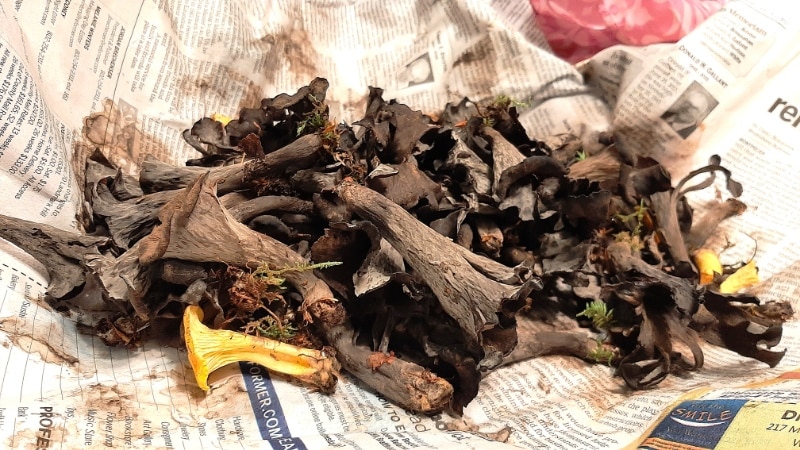
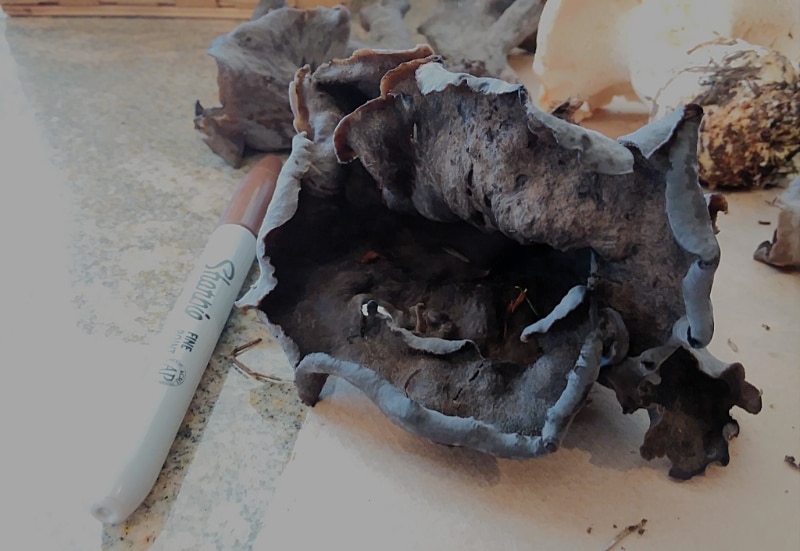
Cleaning Process For Black Trumpet Mushrooms
The cleaning method for black trumpets is very thorough because there is such a high chance of missing some dirt or debris that blends right in with the mushroom. Don’t skip the second rinse! Biting into a gritty mushroom is not something we’d recommend. Wash the mushrooms meticulously to ensure you have the absolute best dining experience with these amazing wild mushrooms.
- You’ll need two bowls of cold water to clean the mushrooms thoroughly.
- Put the mushrooms in the first bowl and swirl them gently for a few minutes. These mushrooms break easily, so don’t be too aggressive with them. If there’s any heavy grit, it will quickly sink. And any floating debris will rise to the top.
- Using your fingers, strain the mushrooms out of the bowl. The dirt should all be at the bottom of the bowl and easily avoided. The debris at the top can be picked out or moved aside as you scoop the mushrooms out.
- As you strain the mushrooms out of the first bowl, add them to the second.
- Repeat the process of swirling and straining to remove dirt and debris. Mushrooms from sandy areas might need a third rinsing. Repeat the process as many times as needed to ensure clean mushrooms!
- Lay the mushrooms to dry in a single layer on paper or cloth towels where air circulates well. Placing them near a window or warm spot helps speed up the drying if the sun is out. A salad spinner also removes excess water nicely, but it can be too rough for the delicate trumpets. If you use a salad spinner, do it slowly.
- It won’t take a super long time for them to dry since they’re so thin. They do get a little waterlogged during this process, but it isn’t terrible. We find that if you wash them a couple of hours before you intend to cook with them, that works great. Or, if you are planning on dry sautéing the black trumpets, you don’t have to worry about drying them at all.
Common cleaning mistakes
Poor cleaning can ruin your black trumpet mushrooms’ quality.
- If you neglect to trim the base of the mushroom when you harvest, all the collected mushrooms will get dirtier in the basket. Cutting off the stem base and giving the mushrooms a little shake will help leave embedded dirt and grit behind.
- Not checking the inside cavity might mean lots of dirt or tiny insects in the mushrooms.
- Soaking them too long will damage their texture.
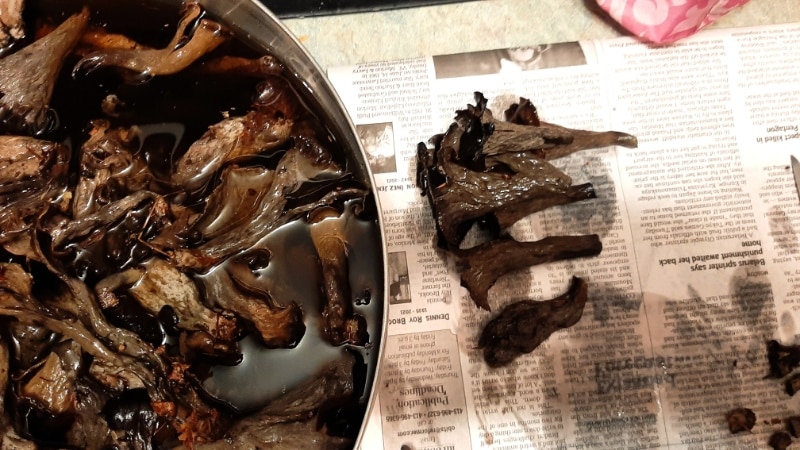
Cooking With Black Trumpet Mushrooms
Black trumpet mushrooms have a delicate texture and robust flavor, making them perfect for different cooking methods that bring out unique tastes. It’s best to let this mushroom be the star of the dish. Black trumpets aren’t hardy enough to be the bulk of the meal, but their flavor profile and aroma should be catered to.
Black trumpets are the accompaniment to a dish that boosts the flavor profile of the entire meal. To make a dish with flavors that overpower the taste of the black trumpets is a disservice to the mushroom. It often doesn’t take much to get the black trumpet taste in a soup or stir-fry.
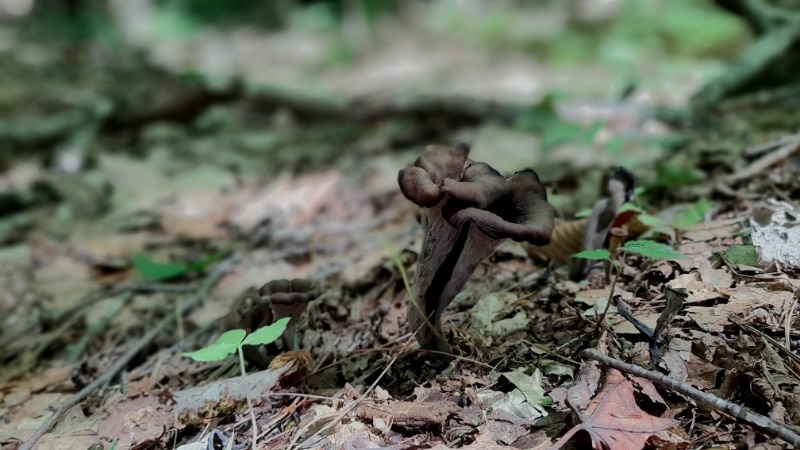
Sautéing
A quick way to prepare black trumpet mushrooms is to melt butter in a large skillet over medium-high heat. Add minced garlic and cook until fragrant, approximately 1-2 minutes. The mushrooms go in next – sauté them for 5-7 minutes until they turn tender with a light brown color. You can add shallots to boost the flavor and cook everything together for about 10 minutes.
Roasting
Roasting brings out black trumpet mushrooms’ natural flavors. Heat your oven to 375°F and mix the cleaned mushrooms with olive oil, garlic, and your favorite herbs. Place them on a baking sheet and roast for 15-20 minutes until they become tender with light browning. For crispy mushrooms, you can roast at 425°F for 5-6 minutes on each side.
Adding to soups and sauces
Black trumpet mushrooms add incredible depth to soups and sauces. When making cream-based soups, cook the mushrooms in butter until tender. Add garlic and shallots during the final minute. The mushroom’s cooking juices will make your soup taste incredible.
They’re perfect in wild mushroom risottos, hollandaise sauces, and gravies, adding an elegant touch to classic dishes.
Mushroom butter
Mushroom compound butter is an incredible way to make the best use of this mushroom’s strong, musky, fruity aroma. Start by cooking the black trumpets with minced shallots in olive oil until they caramelize. Let the mixture cool, then blend it with room-temperature butter. Add some Worcestershire sauce and fresh lemon juice for extra flavor. This butter works great with steaks, vegetables, pasta dishes, and pan sauces.
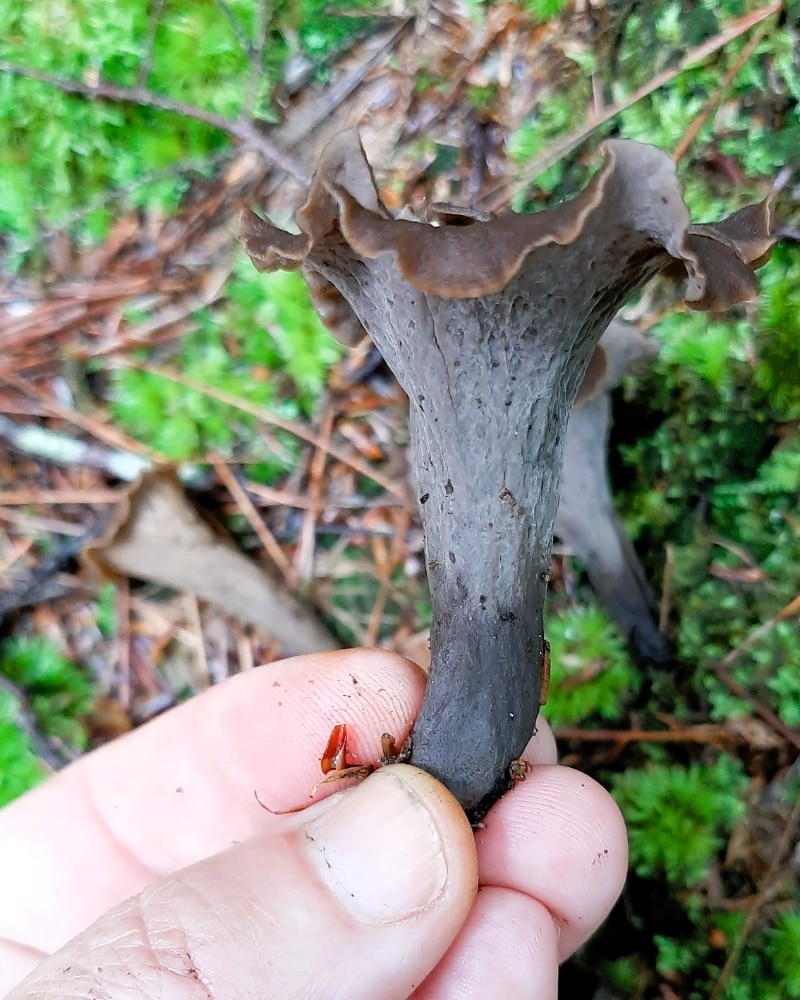
Our Favorite Black Trumpet Mushroom Recipes
- Black Trumpet Mushroom Sauce with Cream and Fresh Tarragon
- Black Trumpet Mushroom Salt
- Stuffed Patty Pans with Black Trumpets
- Wild Trumpet Bruschetta Recipe
- Maple Black Trumpet Mushroom Jam
- Black Trumpet Omelette
- Black Trumpet Arancini (Air Fried)
- Black trumpet mushroom gravy sauce
- Black Trumpet Mushroom Spread
Black Trumpet Mushroom Storage and Preservation
Black trumpet mushrooms need proper storage to keep their delicate flavor and texture intact. These prized fungi stay fresh through several preservation methods. You can enjoy them in your favorite recipes throughout the year.
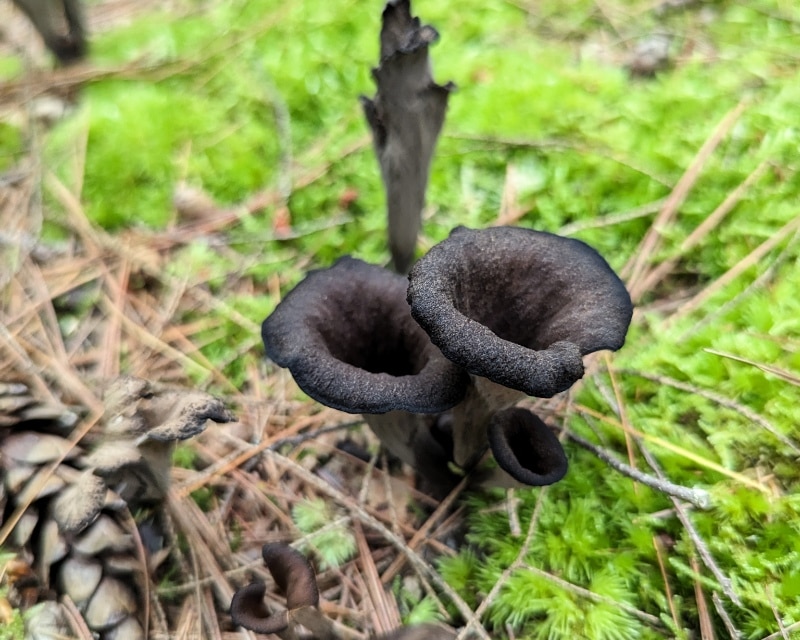
Fresh storage
The best way to store black trumpet mushrooms short-term is in a brown paper bag with a very lightly damp paper towel on top. The bag should go in your refrigerator’s upper section, not the vegetable drawer, which gets too cold. Fresh black trumpets last 7-10 days this way. Do not wash or clean them beforehand. If the mushrooms are at all wet when they go in the refrigerator, they’ll rot quickly.
Drying
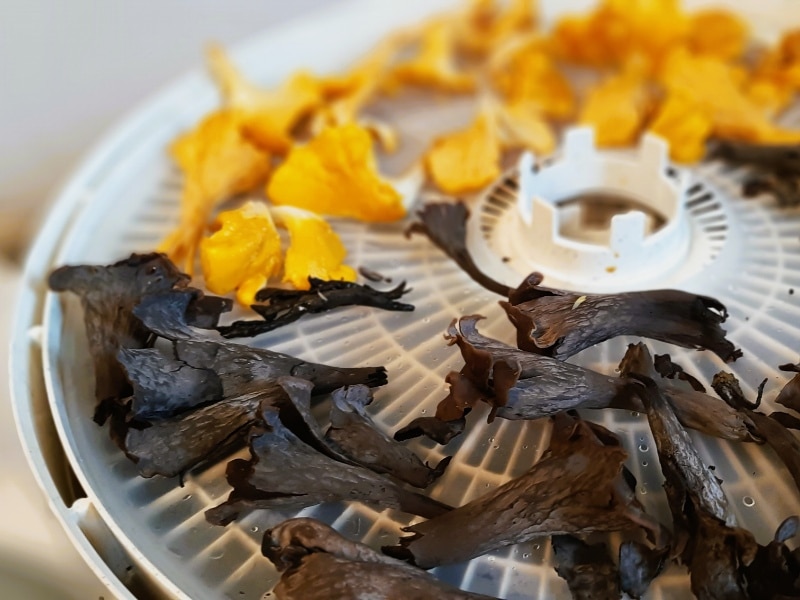
Dehydration is one of the best ways to preserve black trumpet mushrooms because it makes the mushrooms’ truffle-like aroma and flavor even better. Set the dehydrator to 113°F and run for about 5 hours. The drying time depends on quantity, so check every 2 hours. The mushrooms should be completely dry and crumbly to the touch. If they are still pliable, they need more drying.
You can also dry them in these ways:
- Spread them on screens in direct sunlight for 12 hours
- Put them near a wood-burning stove or heater
- Set your oven to its lowest temperature with the door slightly open
Store the dried black trumpet mushrooms in glass jars with airtight seals. The jars need to be opened daily for an hour during the first week to let out any extra moisture. This ensures that they can last for a long time without developing any mold. If there is any dampness, they’ll get moldy after a while. Black trumpets stay good for up to 2 years when dried and stored correctly.
Rehydrating
Dried black trumpets just need to be soaked in tepid water for 15-20 minutes. These rehydrated mushrooms work well in many dishes, from quick sautés to hearty soups. Some recipes taste even better with dried black trumpets because the drying concentrates their unique flavors.
Common Questions About Cooking Black Trumpet Mushrooms
What’s the best way to cook black trumpet mushrooms?
An easy and delicious method for cooking black trumpet mushrooms is to simply sauté them in butter. You can also roast them in the oven or add them into soups and sauces for added depth of flavor.
Are black trumpet mushrooms safe to eat?
Yes, black trumpet mushrooms are a choice wild edible mushroom with no poisonous look-alikes. They have a complex, rich, and earthy flavor with subtle fruity notes.
How long can I store fresh black trumpet mushrooms?
Fresh, unwashed black trumpet mushrooms can be stored in a brown paper bag with a damp paper towel on top in the refrigerator for 7-10 days. Cleaned mushrooms have a shorter shelf life.
What’s the best method for preserving black trumpet mushrooms?
Drying is the best preservation method for black trumpet mushrooms. The deep and unique aroma and flavor of the mushrooms concentrate with drying. Properly dried and stored black trumpets can maintain their quality for up to 2 years.
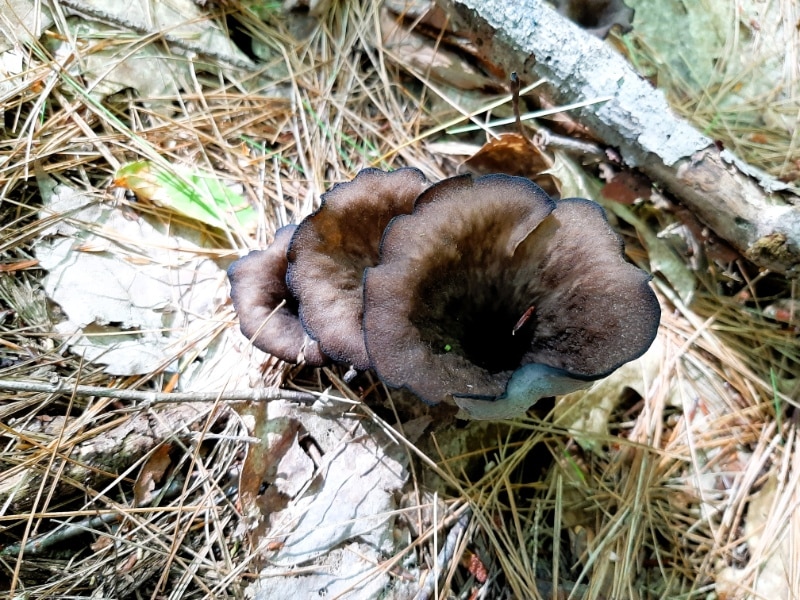

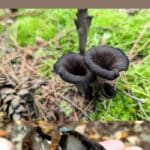

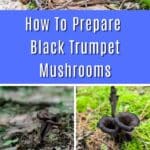


Leave a Reply